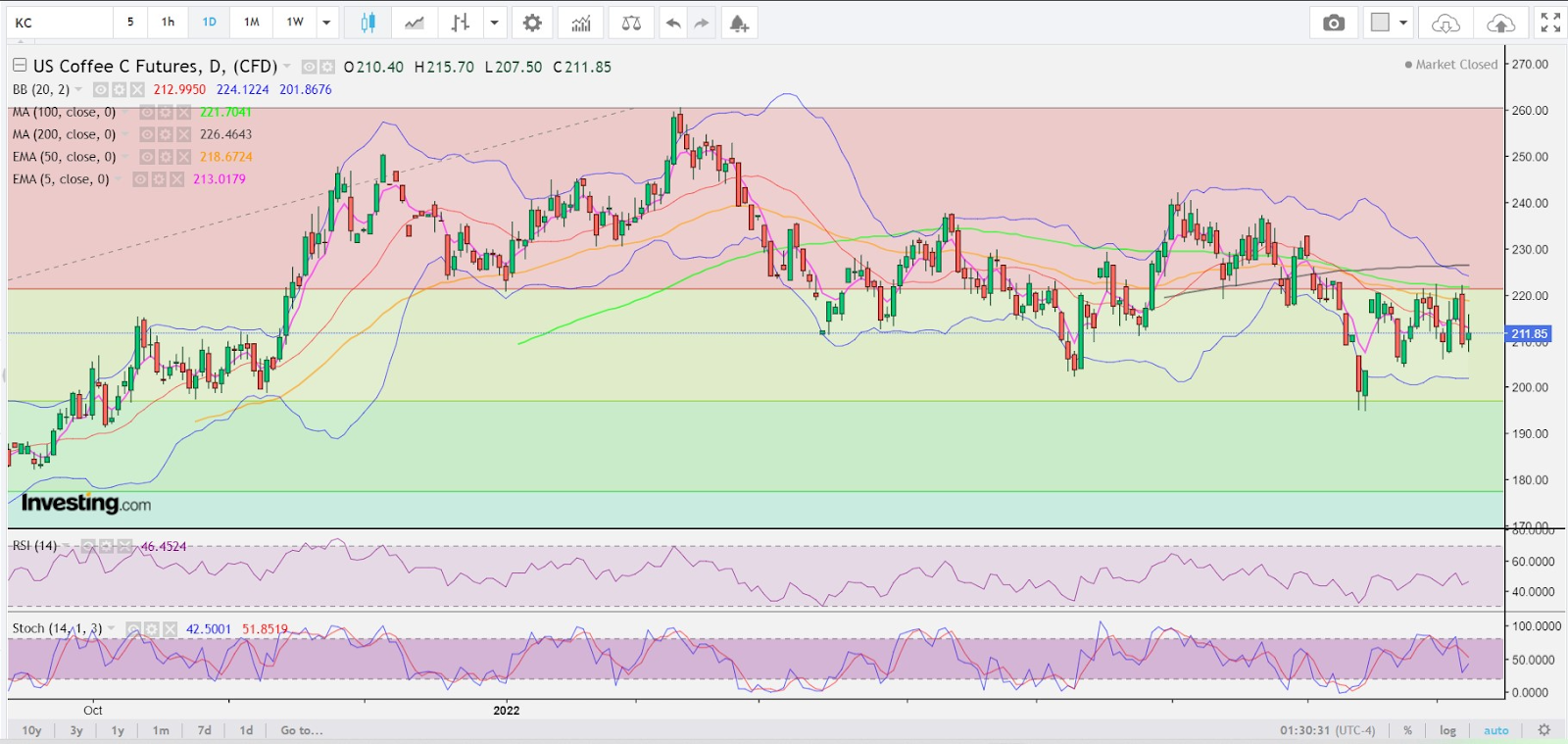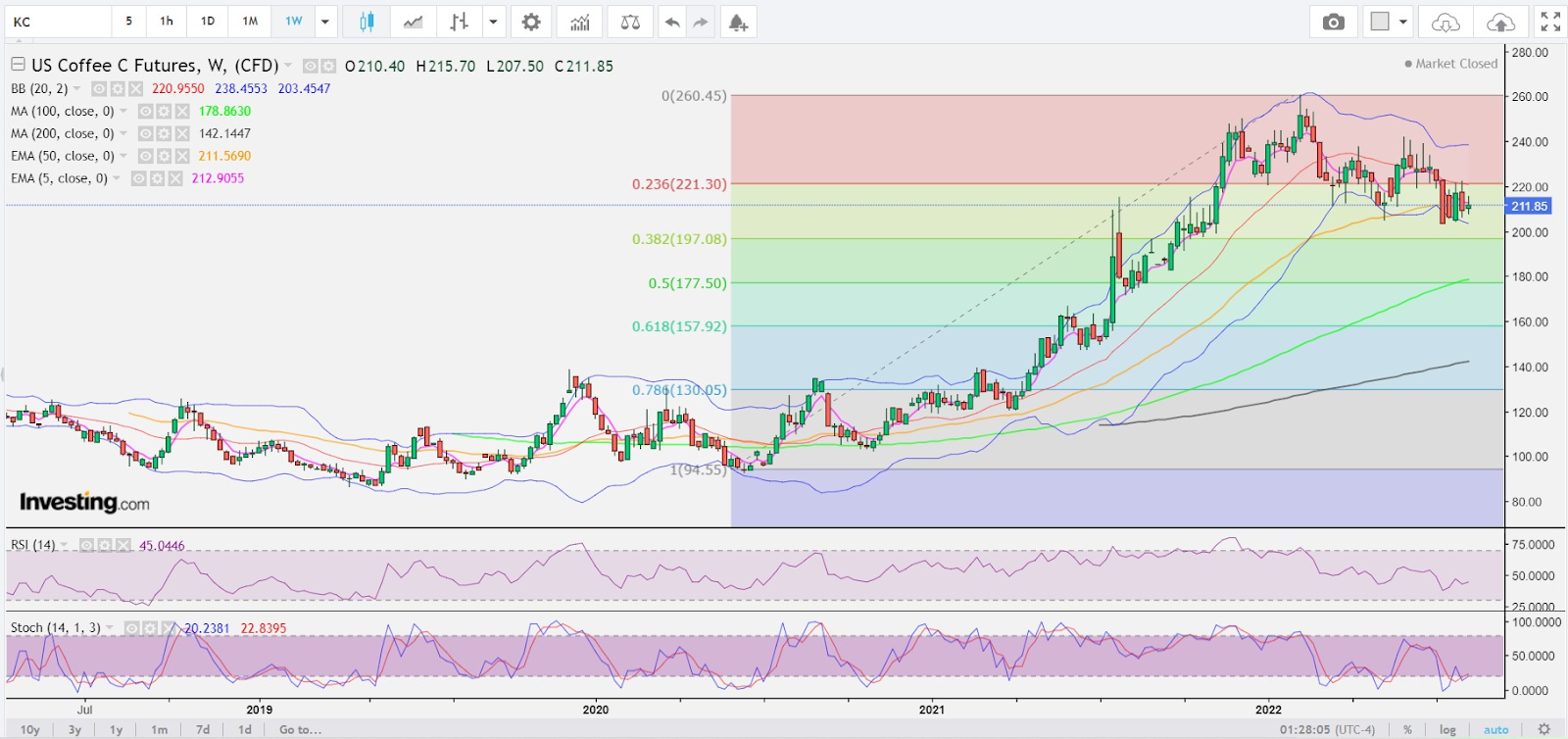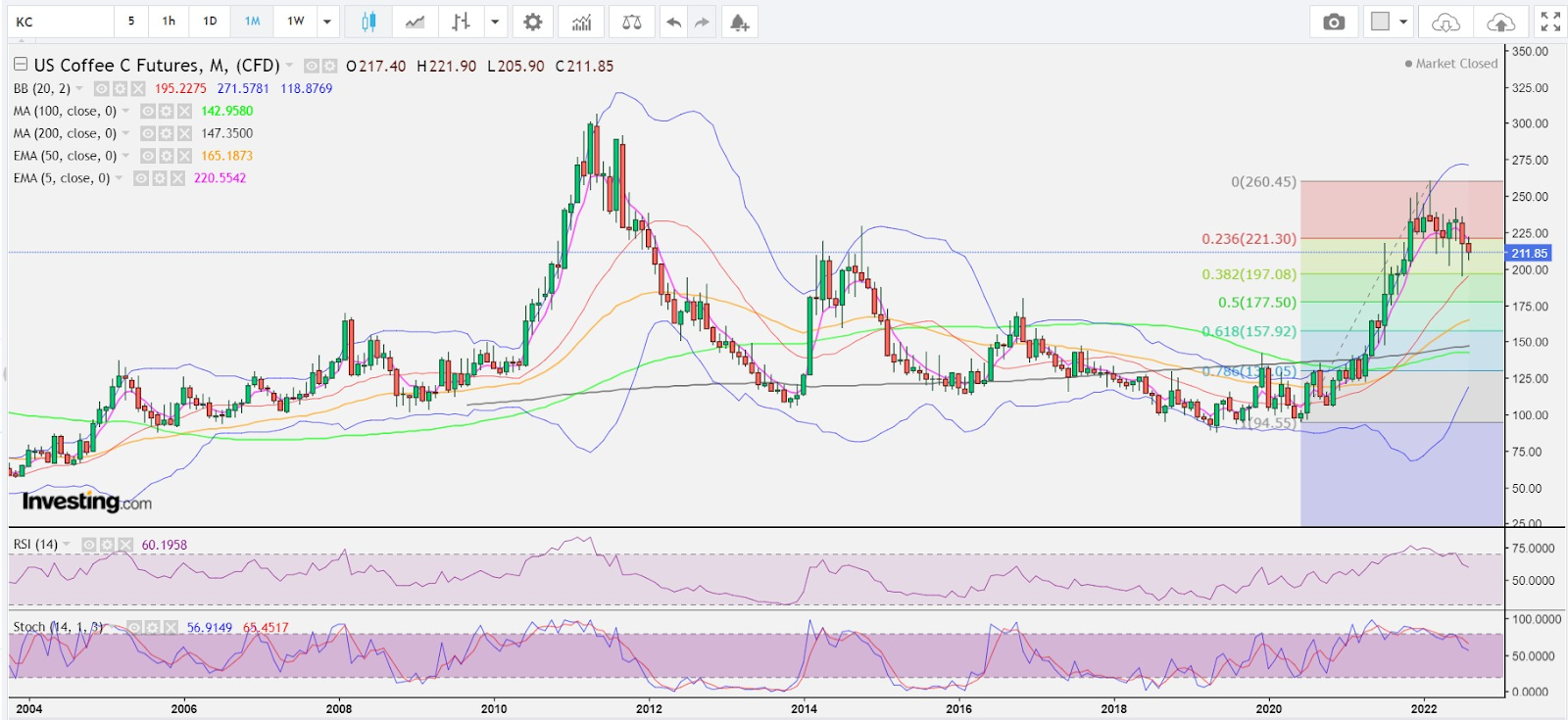- Starbucks’ sales roar while the raw price of arabica coffee plummets
- The disconnect is in production of cocoa beans, which is above need
- Technicals suggest arabica could go to as low as $1.77 per lb
“What inflation?” Starbucks (NASDAQ:SBUX) CEO Howard Schultz asks as the world’s most well-known coffee chain reported better-than-expected quarterly earnings and revenue last Tuesday amid talk of American consumers cutting back on everything, including their favorite beverages, as recession bites.
But a look at coffee’s arabica futures trading on New York’s Intercontinental Exchange (ICE) might tell a different story.
Arabica hit a nine-month low beneath $2 per lb on July 15 and lost 7% for all of last month, its most in 16 months. Now, a week into August, the premium coffee bean is down almost 2.5%.
If arabica’s price doesn’t recover by the time August ends—or its loss deepens—it will be its sharpest dip in the red over a two-month period since an 18% drop over the September-October 2020 stretch.

Charts by SKCharting.com, with data powered by Investing.com
What’s causing the disconnect between resilient consumer appetite for great-tasting lattes, mochas, and other espresso drinks with the raw price of coffee?
It appears to be mostly production of coffee—or, to be specific, more beans than the market needs.
Jack Scoville, chief crop analyst at Chicago’s Price Futures Group, pointed to Brazil, the world’s largest coffee grower, particularly of arabica beans:
“Demand for coffee overall is thought to be less [but] the weather in Brazil is good for coffee production and any harvest activities.”
“Temperatures are above normal in Brazil and conditions are mostly dry. The dry weather is raising some concerns about the next crop potential but it is normally dry at this time of year.”
Rabobank warned recently that if Brazil's output remains good as of mid-August, arabica will face more pressure as the frost risk premium will disappear.
Brazilian farmers had harvested 83% of the 2022/23 coffee crop by August 2, consultancy Safras & Mercado said on Friday.
Dry weather and efficient field work could produce even more arabica over the next seven to 10 days with no forecast for widespread rains in the coffee belt, Safras' coffee analyst Gil Barabach said.
Barabach said in the report, however, that coffee supplies being offered in the physical market in Brazil, particularly of the arabica type, remain below levels expected for this time of the year.
The analyst said the situation "turns an alert light on" regarding Brazil's coffee production potential this year.
Thus, the consultancy said it wasn’t changing its estimate for this year’s Brazil crop, projecting the 2022 Brazilian coffee crop at 61.1 million bags, well above the government's estimate of 53.4 million bags.
Back to the Starbucks story, CEO Schultz said the chain is not seeing customers trade down or reduce their spending.
Other restaurant companies, including McDonald’s (NYSE:MCD) and Chipotle Mexican Grill (NYSE:CMG), have seen low-income consumers visit less frequently or spend less as higher gas and grocery bills squeeze their budgets. Schultz credited Starbucks’ pricing power and customer loyalty for its ability to buck the trend.
In Starbucks’ home market, same-store sales increased 9%, driven largely by higher average order totals, as well as a 1% uptick in traffic. Morning sales are returning, the company said, making up roughly half of revenue as consumers resume pre-pandemic routines.
The company also noted the popularity of its iced shaken espresso and said cold beverages accounted for three-quarters of US sales this quarter. Schultz said customers are more likely to add modifiers like syrups and milks to cold drinks than hot drinks, raising the price of the overall beverage. Cold drinks are also popular with Gen Z customers, a key demographic for the coffee chain, according to Schultz.
Outside the United States, same-store sales fell 18%, weighed down by plummeting demand in China. Starbucks said COVID restrictions affected sales in its second-largest market for two-thirds of the quarter. As a result, China’s same-store sales plunged 44%. The company is still seeing periodic short-term closures in China.
Last quarter, Starbucks pulled its outlook for fiscal 2022, citing the uncertainty caused by COVID outbreaks in China. The company did not issue a new forecast this quarter.
Starbucks opened 318 net new locations worldwide during the quarter, bringing its global restaurant count to 34,948.
Economists tracked by Investing.com are projecting the US Consumer Price Index report, due on Wednesday, will show a growth of 8.7% for the year to July, versus the rise of 9.1% during the 12 months to June. If true, it will be a sign that the Federal Reserve’s efforts in fighting inflation are starting to work.
Yet, a reduction of less than half a percent in year-on-year inflation barely makes a difference to what the Fed is fighting for. The central bank, as we all know, wants to bring inflation back to its long-cherished target of 2% a year; or 4.5 times less than what the CPI was for July.
That suggests that the Fed will have to keep raising rates in the near future to get inflation as close as possible to its target.
Until the release of the US July nonfarm payrolls report last week, the consensus among money market traders was for a 50 basis point hike next month. The report, however, drastically changed those expectations with a job creation more than twice the level forecast by economists.
As of Monday afternoon, Investing.com’s Fed Rate Monitor Tool showed a 67% chance that the September rate hike will be 75 basis points—the same as in June and July. The 75 basis point hike, incidentally, was the highest in 28 years when it was introduced two months back.
Aside from the CPI, the producer price index figures for July will be released on Thursday, along with the weekly report on initial jobless claims, while the University of Michigan consumer sentiment index will be published on Friday.

So, where does this leave the price direction for arabica?
A drop to as low as $1.77 per lb is on the cards if the market doesn’t rebound soon, said Sunil Kumar Dixit, chief technical strategist at SKCharting.com, adding:
“If selling persists below the $2.05 - $195 belt, arabica can drop deeper towards the 100-Week Simple Moving Average of $1.79 and the 50% Fibonacci retracement level at $1.77.”

Failure to make a sustained break above the 200-Day SMA of $2.26 will favor bears for a renewed push down towards the $2.05 - $1.95 support, Dixit said.
He noted that coffee had been on a bearish path since February, when it topped $2.60 and the subsequent correction took it to $1.94, which was slightly below the monthly middle Bollinger Band of $1.95 and the 38.2% Fibonacci retracement of $1.97.
But if the market reverses tack, then the 200-Day SMA of $2.26 will act as first resistance to the swinger higher towards $2.40.
Disclaimer: Barani Krishnan uses a range of views outside his own to bring diversity to his analysis of any market. For neutrality, he sometimes presents contrarian views and market variables. He does not hold positions in the commodities and securities he writes about.
